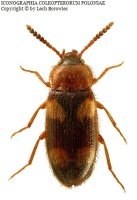
Русские, остановите эту войну! Спасите Свободную Украину!
Russians, stop this war! Save Free Ukraine!
Biodiversity Map
Taxa

Mycetoxides — subordinate taxa:
Taxon count: 1
-
Arthropodaphylum
Click to switch
to select orders
and filters > -
Hexapodasubphylum
Click to switch
to select orders
and filters > -
Insectaclass
Click to switch
to select orders
and filters > -
Coleopteraorder
Click to set
as the main taxon
and as a base
← of the left panel > -
Polyphagasuborder
Click to set
as the main taxon
and as a base
← of the left panel > -
Cucujiformiaseries
Click to set
as the main taxon
and as a base
← of the left panel > -
Tenebrionoideasuperfamily
Click to set
as the main taxon
and as a base
← of the left panel > -
Mycetophagidaefamily
Click to set
as the main taxon
and as a base
← of the left panel > -
Mycetophaginaesubfamily
Click to set
as the main taxon
and as a base
← of the left panel > -
Mycetophaginitribe
Click to set
as the main taxon
and as a base
← of the left panel > -
Mycetophagusgenus
Click to set
as the main taxon
and as a base
← of the left panel > -
Mycetoxidessubgenus
Click to set
as the main taxon
and as a base
← of the left panel >
PL
YES
name status: valid name
BioMap ID: 1020465
taxon code: 3717
taxonomy checked: YES
Data on distribution in Poland

Statistics
- Records: 145
- Publications: 43
- Collections: 7
- Publication authors: 51
- Illustrations (iconography): 1
- Photos (specimen/observation): lacking
Taxon description
Gatunek znany głównie ze wschodniej części Europy, rozmieszczony od północnej Szwecji, środkowej Finlandii oraz Karelii przez całą środkową Europę aż do Włoch i Grecji, notowany poza tym z nielicznych stanowisk z północnej Szkocji, dwu południowych prowincji Norwegii oraz z Francji (zwłaszcza północnej, ale bez wybrzeży). Wszędzie sporadycznie i bardzo rzadko spotykany. W Polsce znany z nielicznych stanowisk rozmieszczonych w dziewięciu krainach. Poławiany w starych, opuszczonych chodnikach kózek i korników, w zmurszałym drewnie i pod przegrzybioną korą różnych drzew liściastych, zwłaszcza buków, lip, brzóz i osik; w Szwecji znajdowany również pod korą powalonych świerków.
Illustrations
... browse
 Mycetophagus
Mycetophagusfulvicollis
External data sources
- Ostatnie rekordy
-
1081241
 ×
× Mycetophagidae: Mycetophagus fulvicollis, PL, Puszcza Białowieska, podlaskie, nadl. Hajnówka, 2017, leg. R. Plewa
Mycetophagidae: Mycetophagus fulvicollis, PL, Puszcza Białowieska, podlaskie, nadl. Hajnówka, 2017, leg. R. Plewa -
1081240
 ×
× Mycetophagidae: Mycetophagus fulvicollis, PL, Puszcza Białowieska, podlaskie, nadl. Hajnówka, 2017, leg. R. Plewa
Mycetophagidae: Mycetophagus fulvicollis, PL, Puszcza Białowieska, podlaskie, nadl. Hajnówka, 2017, leg. R. Plewa -
1057507
 ×
× Mycetophagidae: Mycetophagus fulvicollis, PL, Nizina Wielkopolsko-Kujawska, ad Piła, UTM XU18, 1999, leg. R. Ruta
Mycetophagidae: Mycetophagus fulvicollis, PL, Nizina Wielkopolsko-Kujawska, ad Piła, UTM XU18, 1999, leg. R. Ruta -
1057506
 ×
× Mycetophagidae: Mycetophagus fulvicollis, PL, Nizina Wielkopolsko-Kujawska, ad Piła, UTM XU18, 1999, leg. R. Ruta
Mycetophagidae: Mycetophagus fulvicollis, PL, Nizina Wielkopolsko-Kujawska, ad Piła, UTM XU18, 1999, leg. R. Ruta -
947729
 ×
× Mycetophagidae: Mycetophagus fulvicollis, East Beskid Mts., rez. Turnica, UTM FV19 (Trella 1923b, Kubisz et al. 2015)
Mycetophagidae: Mycetophagus fulvicollis, East Beskid Mts., rez. Turnica, UTM FV19 (Trella 1923b, Kubisz et al. 2015) -
947728
 ⊡
⊡ Mycetophagidae: Mycetophagus fulvicollis, PL, Beskid Wschodni, Przemyśl, Prałkowce, UTM FA21 (Trella 1923b, Kubisz et al. 2015)
Mycetophagidae: Mycetophagus fulvicollis, PL, Beskid Wschodni, Przemyśl, Prałkowce, UTM FA21 (Trella 1923b, Kubisz et al. 2015) -
947727
 ×
× Mycetophagidae: Mycetophagus fulvicollis, East Beskid Mts., Hołubla, UTM FA11, 1884 (Kubisz et al. 2015)
Mycetophagidae: Mycetophagus fulvicollis, East Beskid Mts., Hołubla, UTM FA11, 1884 (Kubisz et al. 2015) -
947726
 ×
× Mycetophagidae: Mycetophagus fulvicollis, East Beskid Mts., Góra Kanasin, UTM FV19, 2010 (Ruta et al. 2012, Kubisz et al. 2015)
Mycetophagidae: Mycetophagus fulvicollis, East Beskid Mts., Góra Kanasin, UTM FV19, 2010 (Ruta et al. 2012, Kubisz et al. 2015) -
947725
 ×
× Mycetophagidae: Mycetophagus fulvicollis, East Beskid Mts., Góra Kanasin, UTM FV19 (Ruta et al. 2012, Kubisz et al. 2015)
Mycetophagidae: Mycetophagus fulvicollis, East Beskid Mts., Góra Kanasin, UTM FV19 (Ruta et al. 2012, Kubisz et al. 2015) -
947724
 ×
× Mycetophagidae: Mycetophagus fulvicollis, East Beskid Mts., Brylińce, UTM FA10 (Trella 1923b, Kubisz et al. 2015)
Mycetophagidae: Mycetophagus fulvicollis, East Beskid Mts., Brylińce, UTM FA10 (Trella 1923b, Kubisz et al. 2015) - ... more
- Powiązane publikacje
-
Plewa R., Jaworski T., Hilszczański J., Horák J. 2017a. Investigating the biodiversity of the forest strata: The importance of vertical stratification to the activity and development of saproxylic beetles in managed temperate deciduous forests. For. Ecol. Manage., 402:186-193.
 Show records
Show records -
Kubisz D., Iwan D., Tykarski P. 2015. Tenebrionoidea: Mycetophagidae, Ciidae, Mordellidae, Zopheridae, Meloidae, Pyrochroidae, Salpingidae, Anthicidae. Critical checklist, distribution in Poland and meta-analysis. Coleoptera Poloniae, 3, University of Warsaw – Faculty of Biology, Natura optima dux Foundation, Warszawa.
 selected pages
selected pages Show records
Show records -
Grzywocz J., Szołtys H., Królik R., Greń Cz., Szczepański W.T., Mazur M.A. 2015. Chrząszcze (Coleoptera) Śląska Dolnego i Górnego – dotychczasowy stan poznania oraz nowe dane faunistyczne: Mycetophagidae. Acta Ent. Siles., 23(online 006):1-10.
 Show records
Show records -
Plewa R., Jaworski T., Hilszczański J. 2014b. Martwe drewno a jakościowa i ilościowa struktura chrząszczy (Coleoptera) saproksylicznych w drzewostanach dębowych. Studia i Materiały CEPL w Rogowie, 41(4):279-299.
 Show records
Show records -
Mokrzycki T., Borowski J., Byk A., Rutkiewicz A. 2013. Waloryzacja ekosystemów Leśnego Kompleksu Promocyjnego „Lasy Spalsko-Rogowskie” na podstawie struktury zgrupowań chrząszczy (Coleoptera) zasiedlających pniaki. Studia i Materiały CEPL w Rogowie, 2(35):48-81.
 Show records
Show records - ... more





